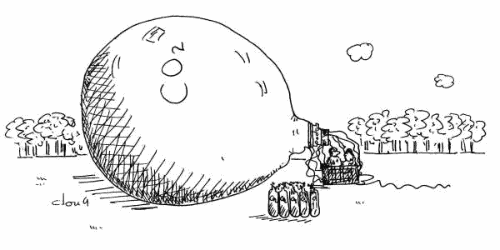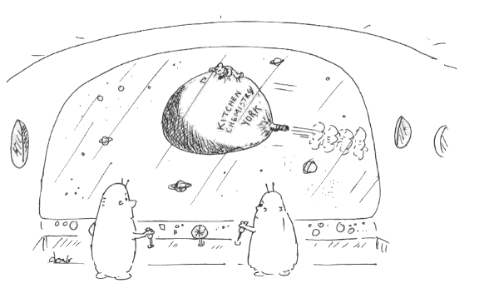 Download this page as an activity sheet (pdf, 113KB). Download this page as an activity sheet (pdf, 113KB).
It's a Gas!
In this activity, you can:
Please follow any safety instructions highlighted like this in red.
How to make fizzy drinks
It's easy to make your own special Fizz Powder which, when added to drinks, makes them fizzy. You will need:
- citric acid crystals,
- bicarbonate of soda (baking soda),
- icing sugar.
Note that the citric acid crystals must be food grade, which you can find in the baking section of your supermarket, or get from chemists and home-brew suppliers. To make some fizz powder, here's what you need to do:
- Add 6 teaspoons of citric acid crystals to 3 tablespoons of bicarbonate of soda in a bowl.
- Crush the mixture with a spoon to form a fine powder.
- Now add 2 tablespoons of icing sugar, mix thoroughly and put into a dry jar labelled FIZZ POWDER.
- To use the powder, put 2 teaspoons into a glass and fill it up with the still drink of your choice.
How does the fizz powder work? – the science bit
The citric acid reacts with the carbonate in bicarbonate of soda to form carbon dioxide gas. These bubbles of carbon dioxide are what make your drink fizzy. You can find out more about carbonates and acids here.
Why not test the acidity of different drinks? – further investigations
Add a teaspoon of bicarbonate of soda to half a glass of a drink (for example, grapefruit juice) and half a glass of a different drink (for example, orange squash). Whichever drink fizzes most is the more acidic! You can find another way of testing for acidity here.
Back to the top.
How to make sherbet
Using the same ingredients as the fizz powder you can also make sherbet! Simply follow steps 1 and 2 above for the fizz powder, but then add 4 tablespoons of icing sugar instead. When you put the sherbet on your tongue, the citric acid crystals dissolve and react with the bicarbonate of soda. This produces bubbles of carbon dioxide gas, which cause the fizzy feeling on your tongue.
Back to the top.
The easy way to inflate a balloon – without blowing!

"I know it's cheap, plentiful and non-flammable but there's a drawback with this gas..."
Yes, you can inflate a balloon without blowing into it yourself! You will need:
- vinegar,
- bicarbonate of soda (baking soda),
- a bottle,
- a balloon.
Here's what to do:
- Pour about 20 ml of vinegar into the bottle.
- Put 2 teaspoons of baking soda into the balloon.
- Attach the balloon around the neck of the bottle, taking care not to let any baking soda fall into the bottle (you may need some sticky tape to secure the balloon).
- Once the balloon is securely fastened to the bottle, lift the balloon so that the baking
soda is tipped into the bottle. Sit back and watch the balloon inflate!
What makes the balloon inflate? – the science bit
When you tip the baking soda out of the balloon into the bottle, it mixes with the vinegar and a chemical reaction produces carbon dioxide gas. As the gas can't escape, the balloon inflates.
Back to the top.
Use a rocket to blow your top!

"Not another Science on the Shelves rocket!"
WARNING! This experiment produces a high-speed projectile! Follow all highlighted safety instructions and wear safety goggles.
Rockets and explosives function by generating huge volumes of gas in a short time.
You can create your own rocket using citric acid and baking soda. You can also use vinegar and baking soda, but citric acid is preferable because things don't take off until you add water and it's not so smelly! Doing this outside is also preferable as it makes a mess. You will need:
- a small plastic photo film canister (translucent ones are best),
- bicarbonate of soda (baking soda),
- citric acid crystals, or vinegar.
Here's what to do:
- Mix about a 1/4 teaspoon of baking soda and citric acid crystals in the film canister.
- Add a few drops of water, quickly snap the lid into place and stand clear. If you use vinegar, put the baking soda in first, then snap on the lid as soon as you've put in a few drops of vinegar.
- The lid should blow off dramatically after a short time, but be patient!
Never allow anyone to look over the top once the canister is charged. If it fails to go off (as it does sometimes if there's a small leak around the lid) or seems to have failed, open it very carefully keeping your face well away.
Why is the top blown off? – the science bit
When the citric acid crystals and baking soda dissolve in the water they react with one another producing carbon dioxide gas. The pressure builds up inside the film container until the point at which it can force the lid off. The lid then blows off and the pressure is released.
Can you control the explosion? – further investigations
You can time how long it takes for the lid to come off and experiment with quantities,
mixing and so forth, until you can get the lid to come off after exactly one minute, say. |

